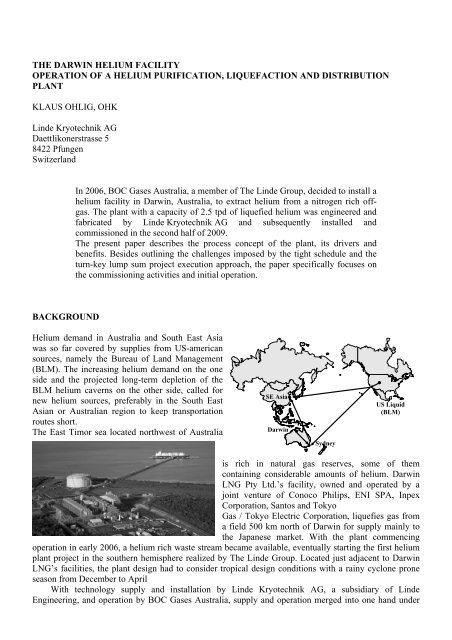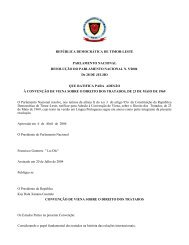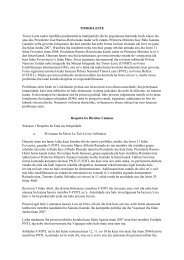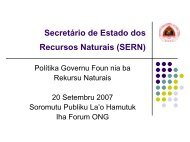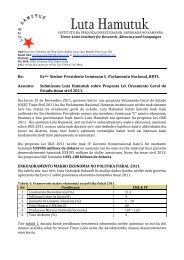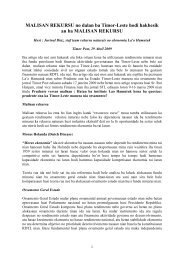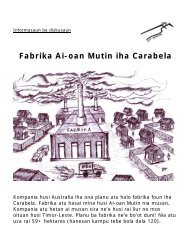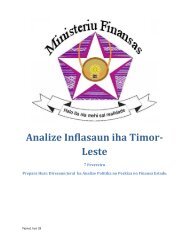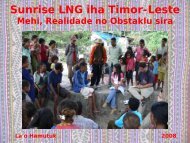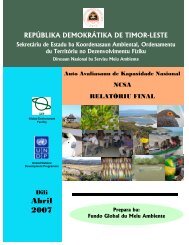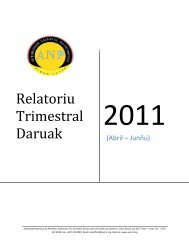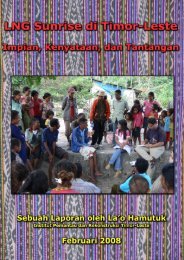THE DARWIN HELIUM FACILITY OPERATION OF A ... - La'o Hamutuk
THE DARWIN HELIUM FACILITY OPERATION OF A ... - La'o Hamutuk
THE DARWIN HELIUM FACILITY OPERATION OF A ... - La'o Hamutuk
Create successful ePaper yourself
Turn your PDF publications into a flip-book with our unique Google optimized e-Paper software.
<strong>THE</strong> <strong>DARWIN</strong> <strong>HELIUM</strong> <strong>FACILITY</strong><br />
<strong>OPERATION</strong> <strong>OF</strong> A <strong>HELIUM</strong> PURIFICATION, LIQUEFACTION AND DISTRIBUTION<br />
PLANT<br />
KLAUS OHLIG, OHK<br />
Linde Kryotechnik AG<br />
Daettlikonerstrasse 5<br />
8422 Pfungen<br />
Switzerland<br />
In 2006, BOC Gases Australia, a member of The Linde Group, decided to install a<br />
helium facility in Darwin, Australia, to extract helium from a nitrogen rich offgas.<br />
The plant with a capacity of 2.5 tpd of liquefied helium was engineered and<br />
fabricated by Linde Kryotechnik AG and subsequently installed and<br />
commissioned in the second half of 2009.<br />
The present paper describes the process concept of the plant, its drivers and<br />
benefits. Besides outlining the challenges imposed by the tight schedule and the<br />
turn-key lump sum project execution approach, the paper specifically focuses on<br />
the commissioning activities and initial operation.<br />
BACKGROUND<br />
Helium demand in Australia and South East Asia<br />
was so far covered by supplies from US-american<br />
sources, namely the Bureau of Land Management<br />
(BLM). The increasing helium demand on the one<br />
side and the projected long-term depletion of the<br />
BLM helium caverns on the other side, called for<br />
new helium sources, preferably in the South East<br />
Asian or Australian region to keep transportation<br />
routes short.<br />
The East Timor sea located northwest of Australia<br />
SE Asia<br />
SE Asia<br />
Darwin<br />
Sydney<br />
US Liquid<br />
(BLM)<br />
is rich in natural gas reserves, some of them<br />
containing considerable amounts of helium. Darwin<br />
LNG Pty Ltd.’s facility, owned and operated by a<br />
joint venture of Conoco Philips, ENI SPA, Inpex<br />
Corporation, Santos and Tokyo<br />
Gas / Tokyo Electric Corporation, liquefies gas from<br />
a field 500 km north of Darwin for supply mainly to<br />
the Japanese market. With the plant commencing<br />
operation in early 2006, a helium rich waste stream became available, eventually starting the first helium<br />
plant project in the southern hemisphere realized by The Linde Group. Located just adjacent to Darwin<br />
LNG’s facilities, the plant design had to consider tropical design conditions with a rainy cyclone prone<br />
season from December to April<br />
With technology supply and installation by Linde Kryotechnik AG, a subsidiary of Linde<br />
Engineering, and operation by BOC Gases Australia, supply and operation merged into one hand under
the umbrella of The Linde Group ensuring an optimal approach to project planning, execution,<br />
commissioning, and start-up.<br />
<strong>THE</strong> PROCESS CONCEPT<br />
Process design was driven by the objective to minimize power consumption and, more importantly,<br />
maximize helium recovery. Plant design bases on a nameplate capacity of 860 l/h of helium with a purity<br />
of 99.999 mol.%.<br />
The feedgas, a nitrogen rich stream with a helium content of approximately 3 mol.%, is provided by<br />
Darwin LNG under a supply agreement based on Minimum-Take-Or-Pay (MTOP) terms. After pipeline<br />
transport over a distance of roughly one kilometre, metering, and initial compression, the bulk of the<br />
nitrogen is removed in the first cryogenic stage operating a liquid nitrogen temperature and increasing the<br />
helium content to 25 mol.%.<br />
As the feed gas contains traces of hydrogen, further processing requires catalytic oxidation with air<br />
and subsequent drying. The helium content is then further enriched to 99 mol.% in a second cryogenic<br />
stage, again operating at liquid nitrogen temperature. This separation step is simultaneously used to<br />
generate high purity nitrogen which – after liquefaction in a dedicated coldbox – is used to provide the<br />
cold for the cryogenic separation processes as well as for nitrogen precooling for helium liquefaction.<br />
Adsorption removes the remaining impurity traces. The purified helium is finally liquefied applying<br />
a modified Brayton cycle with three expansion turbines and then routed to the helium storage atop of the<br />
helium filling facility.
PROJECT EXECUTION CHALLENGES<br />
Besides the complex process scheme, the project depicted further characteristics which rendered project<br />
execution particularly challenging. Due to the greenfield installation, activities were not limited to the<br />
process plant itself, but included civil works and supply of utilities, resulting in a truly lump-sum turnkey<br />
project.<br />
The tight financial budget and the short project<br />
execution period of 24 months from contract signing<br />
to initial start-up were aggravated by the worldwide<br />
economic hype. Procurement and subcontracting<br />
activities concentrated at end of 2007, beginning of<br />
2008 when price levels peaked at historically high<br />
levels. Namely construction activities suffered from<br />
the tight worldwide manpower availability with even<br />
more severe conditions in Australia, particularly at<br />
the remote project location.<br />
The execution challenges were accompanied by<br />
restrictions during commissioning. Utility supply<br />
proved to be unreliable prior to start-up with frequent interruptions in power supply. The remote location<br />
of Darwin with regard to readily accessible infrastructure called for accurate planning to ensure timely<br />
availability of liquid nitrogen and helium on site for cool-down and start-up.<br />
Finally, delayed availability of feed gas from the LNG complex and limitations in feed gas methane<br />
content to avoid hazardous situations at the first nitrogen removal unit impacted the commissioning<br />
schedule towards the end of project execution.<br />
COMMISSIONING AND START-UP<br />
Above all, the joint and cooperative planning of all construction and commissioning activities between<br />
Linde Kryotechnik AG and BOC Gases Australia helped to offset the challenges to a high degree,<br />
minimized delays and led to an excellent HSE result. Linde Kryotechnik AG ensured continuous support<br />
with dedicated supervisors for process design, machinery, electrical engineering, controls, and<br />
commissioning.<br />
Commissioning could successfully be completed<br />
end of December 2009. Cool-down started<br />
immediately afterwards in the first week of January<br />
2010 with the first drop of helium produced only 2<br />
weeks later. Even though the plant had to be stopped<br />
for two weeks end of January due to lack of feedgas,<br />
the first helium container eventually left Darwin on<br />
February 11 th , 2010 – a great success proving that intensive and diligent commissioning activities finally<br />
pay-off by a smooth start-up.<br />
SUMMARY<br />
Despite the challenges induced by financial constraints, tight project schedule, impact of the overheated<br />
worldwide economy and the remote location, the Darwin helium facility turned out to be a great success<br />
story. Diligent planning and, more importantly, the excellent cooperation between the customer, BOC<br />
Gases Australia, and the supplier, Linde Kryotechnik AG, resulted in a highly effective project execution,<br />
thorough commissioning and best-in-class start-up.<br />
The Darwin helium facility is now successfully in operation for more than 6 months. Helium supply<br />
into the Australian and South East Asian markets has since become less dependent from US-american<br />
supply and pricing, and has eventually rendered this first facility in the southern hemisphere an<br />
exceptional success story.


